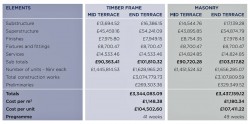Cost comparisons between competing materials are notoriously difficult to quantify in any sector. A recent study from independent construction, property and management consultant, Rider Levett Bucknall, sought to understand the differences between timber frame and masonry in affordable housing.
Rider Levett Bucknall (RLB) has delivered many residential projects. The selection process over the form of construction considers a number of factors including availability, practicality and technical performance. Importantly this process also involves commercial considerations and sometimes the debate over whether masonry or timber is the most economical solution.
“This deliberation is continuing throughout the industry,” said Andrew Reynolds, RLB UK and Global Board Director. “It will be intensified by structural offsite timber solutions becoming increasingly used to fulfil the growing demand for new homes across the UK. Equally there is increasing demand for cross laminated timber (CLT) which is now competing economically with steel and concrete frames. We are pleased to have been able to complete this independent study comparing timber frame to masonry for a conventional housing project.”
Comparing the two build methods is complex as the structures, procurement models and site operations are different. Masonry construction, in general terms, constitutes separate supply chain members and then site assembly of the constituent parts (walls, floors, roof trusses) whereas with timber frame the offsite manufacturer usually designs, manufactures, delivers and erects the whole structural shell of the home, including the roof structure. This presupposes the timber frame company supplies and erects the whole frame (walls, floor and roof).
The building model used for the comparison was an affordable two-storey housing design using two bedroom, four-person dwellings complying with Homes England design standards. The model was then replicated to create a single terrace block of four houses with mid and end-terrace. The affordable house type designs were provided by independent architect and engineering companies. The study compared the buildings only, with the external works and utility services excluded at this stage as these will be very much site-specific in their content, works and any abnormal or risk areas. Also, they are common to both structural solutions and therefore have no bearing on the analysis. It also assumes a continuous build onsite from commencement to completion.
The location of the theoretical project for the study was Birmingham with good access to main trunk roads. From the fully designed project RLB prepared Bills of Quantities for the contractors to price. Four contractors were approached to submit their pricing and all four responded. Contractor information was received regarding the anticipated construction programmes. RLB then used the pricing to formulate the report and the costs summaries.
Andrew Carpenter, Chief Executive of the Structural Timber Association (STA), said: “We welcome this report and the in-depth findings. The STA commends Ian Dacre and Rider Levett Bucknall UK for conducting this research which provides answers to questions that have been debated for many years.
The Construction Cost Comparison Report for Affordable Housing will be of great interest to many members of the construction industry. Whilst cost saving and speed of build are vitally important to affordable housing providers, equally important is the enhanced quality that offsite timber frame construction brings, reducing on-going maintenance costs for social landlords and delivering energy savings for their tenants.”
To continue reading this article, visit: Offsite Magazine Issue 12









